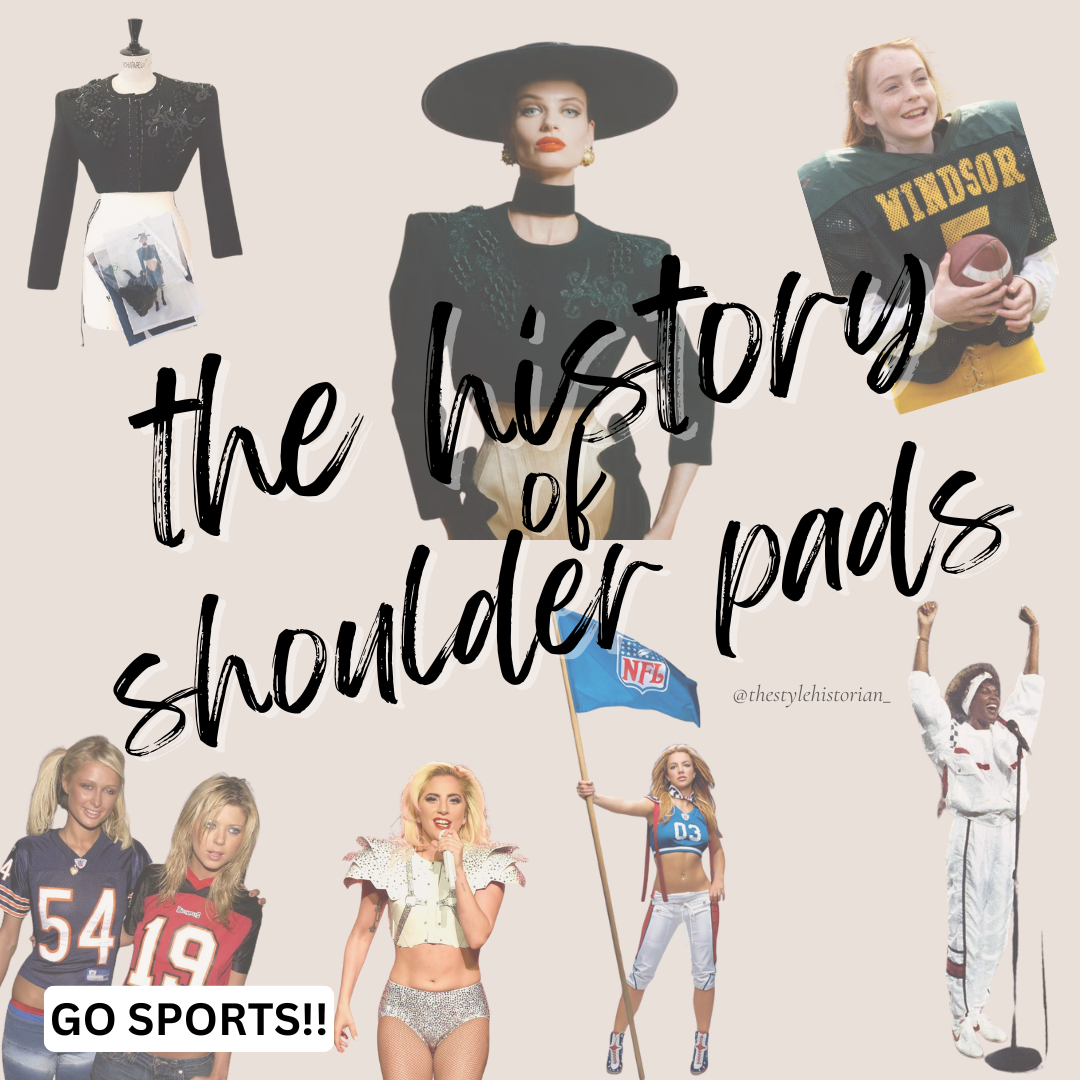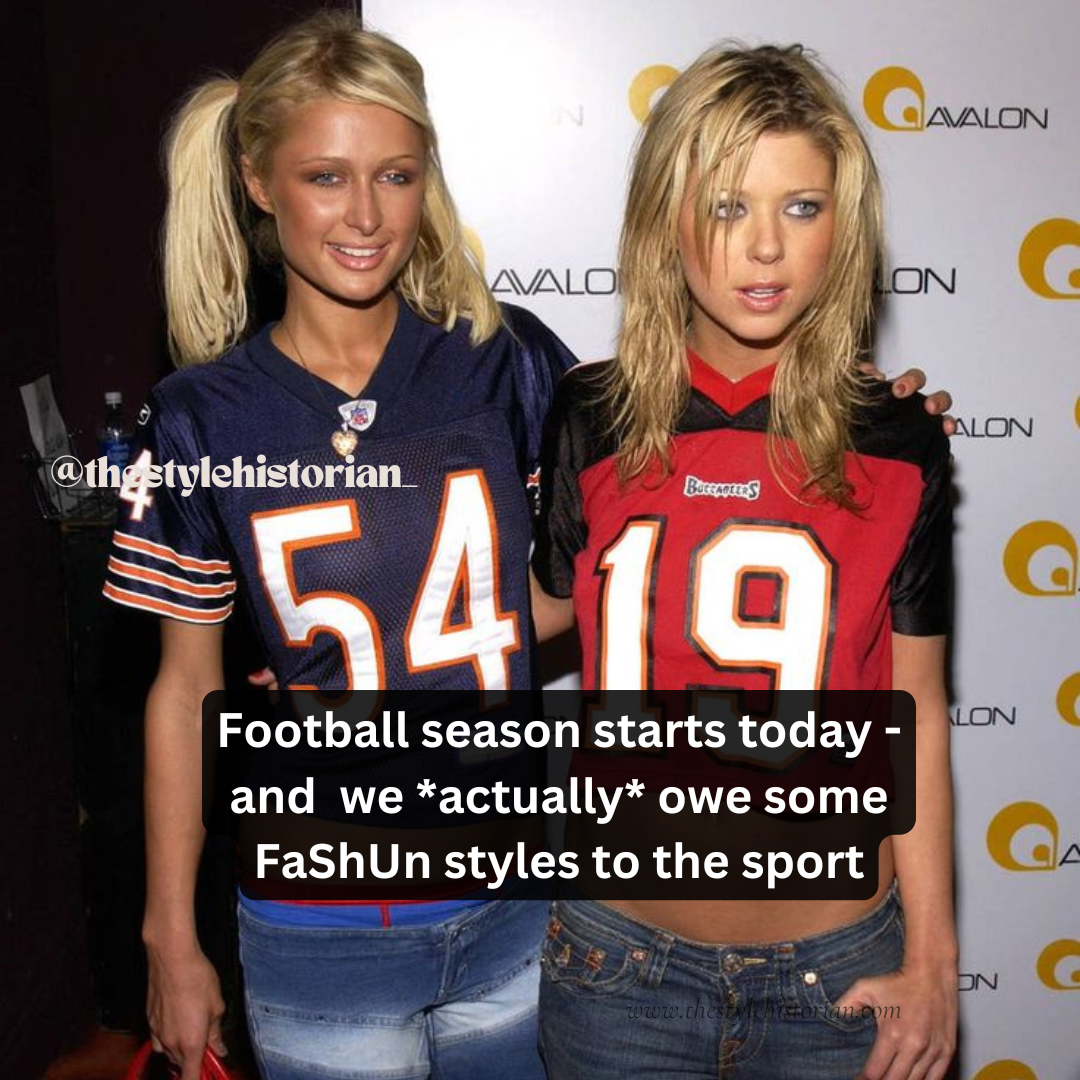The history of shoulder pads. Should you keep them in a vintage garment?
This article was originally published on The Vintage Seeker.
Image Credit: Art by The Style Historian. Photos via Pinterest and Harper's Bazaar.
I’ve never really liked football, but as it turns out, despite years of trying not to be involved in America’s biggest pastime — I really do owe some things to football.
And you might, too.
Image Credit: Pinterest, Art by The Style Historian.
Image Credit: Photo from Pinterest, Art by The Style Historian.
Let me explain.
A brief history of shoulder pads
Using padding to alter the shape of our clothing isn’t a new concept — it dates back to the 1870s and 1880s, when padding was used for the bustles of women’s dresses to extend the fullness at the back.
However, the origins of the fashion shoulder pads we know and love today go back to Princeton University football players in the late 19th century, who developed the pads for protection — but the trend didn’t begin to enter women’s fashion until the 1930s.
Image Credit: Vogue. A strong shouldered Schiaparelli suit. Art by Christian Berard. October 1, 1935.
At that time, women were beginning to accept more masculine-dominated roles and venturing into new spaces. Clothing mirrored this cultural shift.
But it was Elsa Schiaparelli and her experimentation on silhouettes that popularized padding for women’s clothing, namely her structured jackets — it’s well documented that Schiaparelli was inspired by the surrealist art movement, often implementing trompe l’oeil (trick of the eye) to her designs.
Image Credit: Vogue. Joan Crawford wearing Schiaparelli. Photo by Edward Steichen, October 1935.
Image Credit: Vogue. Artwork by Carl Erickson, August 1933.
As we entered the early 1940s, the militarized look swept in from WWII, with a larger-shouldered shape for women — but retreated in popularity when Christian Dior debuted his New Look in 1947 with a return to a more feminine silhouette following the war.
And we know shoulder pads were the moment in the 1980s with the introduction of power dressing, as women increasingly went to work and were clothing themselves to match spaces typically held by only men.
How do we wear shoulder pads now?
As trends have taken over the fashion world with silhouettes becoming more oversized, we’ve seen a return to shoulder pads — and you’ll seldom find a truly vintage blazer without the pads built in.
But the look can be intimidating, if even controversial.
A million thoughts can cross our minds — will this make me look too broad? Is this too exaggerated? Didn’t shoulder pads die in like… the ’80s?
I think it comes down to perspective, a notion not often given to us by the big-box stores or online platforms looking for us to consume.
Everyone’s bodies are uniquely different, and we shouldn’t expect a one-size-fits-all when it comes to any kind of clothing — shoulder pads included.
Sometimes, I keep them in, but other times I don’t — it all comes down to fit and style.
A big part of what goes into shopping for me (and probably you, too!) is evaluating how a specific look will play up or down my features…and also how it makes me feel.
For example, I’m long waisted with broader shoulders, so I seldom need the shoulder pads unless I’m going for a particularly exaggerated silhouette.
But we can’t be scared of shoulder pads. Sometimes, we want more drama. Other times, we don’t.
Often, I choose vintage blazers that have shoulder pads sewn in because it speaks to choosing a unique piece that I know I probably couldn’t find today. A piece that’s likely well made, with real textiles.
One of the biggest thrifting wins I feel is when I see “handmade in Toronto/Canada” on a label — the clothing feels different.
Should you alter your garment to remove shoulder pads?
Personally, I’m a big fan of alterations to my clothing, which helps to both extend the life cycle while making them fit better to suit me.
For example, I tend to look for jeans in bigger sizes so I can have them taken in — especially helpful if you’re someone like me who is in between most traditional sizing (yay!).
Or, if I find something that looks cool but is too big, I’ll take it anyway if I know I’ll be able to alter it to make it work for my specific wants and needs and if not, I gauge whether or not I’ll be able to resell it to offset my costs.
This is something to consider when you come upon an item like a secondhand shoulder-padded garment and are unsure if you want the pads kept in.
A few things to keep in mind about buying an item with shoulder pads:
The garment was specifically designed to fit with pads – if removed, it will likely become a larger fit on top or change the structure itself
With broad shoulders, it’s less likely the fit will change drastically if you remove the pads, but it varies by garment
If you remove the shoulder pads but don’t have substantial shoulders to prop up the droop, it may create an unintentional oversized look and lose the intended fit
Opting to replace smaller/thinner shoulder pads can help maintain the structure of the jacket without having too strong of a shoulder emphasis
Ultimately, it all depends on the vibe you prefer, and what will make you feel best.
Depending on what kind of shoulder pads have been used, you can either carefully cut the thread yourself at home (there are many how-to guides online), or have them altered by a trusted tailor if they’re built inside the garment.
Caring for your shoulder pads
When shopping vintage, there are often questions about how to maintain and prolong the quality (and lifecycle) of your garment.
Much to my surprise, there isn’t much online about caring specifically for shoulder pads. For me, this likely speaks to a larger societal theme — one where we generally are less focused on making things more sustainable, and opt for quick fixes or buying more.
(Though I did find many articles on how to maintain and care for football pads, but I digress.)
However, that doesn’t mean we shouldn’t try — there are shoulder pad inserts you can buy and have sewn in to replace older pads as they lose their shape or the material disintegrates.
And if you find a vintage item that still has the truly OG shoulder pads with Velcro straps keeping them in place, you can always opt to remove them and wash separately in a small garment bag.
That brings us back to today. To shoulder pad or not to shoulder pad?
For me, it’s dealer’s choice — a look you can try, or not try.
As a buyer, it’s completely up to you, and in your control whether or not you decide to keep them in.
But as a seller, if you take them out, you could run the risk of removing the intended structure of the garment or even devaluing it.
Shops to check for shoulder pads
Shoulder pads are a dime a dozen when it comes to thrifting and vintage shopping — any shop that carries 1950s through 1990s will have some garments with them sewn in.
But if you’re looking for some fun vintage and thrift inspo or for your next find, here are three shops that I love.
Undun Vintage
Vancouver-based, they ship across Canada in recyclable materials. Also a great IG follow for the dreamiest of content.
Change is Good
A curated secondhand social enterprise in Calgary that gives all profits to The Calgary Dream Centre, an organization helping those facing homelessness and addiction.
Mine & Yours
A woman-owned luxury resell and consignment business, with locations in both Toronto and Vancouver, and shopping available online.
Until next time,
- TSH
The Style Historian is a lifelong thrifter and style enthusiast passionate about the stories behind the fashion, trends and styles we see today. She covers these histories on her weekly blog, The Style Historian, and on her Instagram. In 2022, she founded the Good Find Studio, in an effort to minimize her closet and live more sustainably. When she’s not researching, she can be found watching a good doc or anything on Bravo, thrifting and spending time outdoors.








